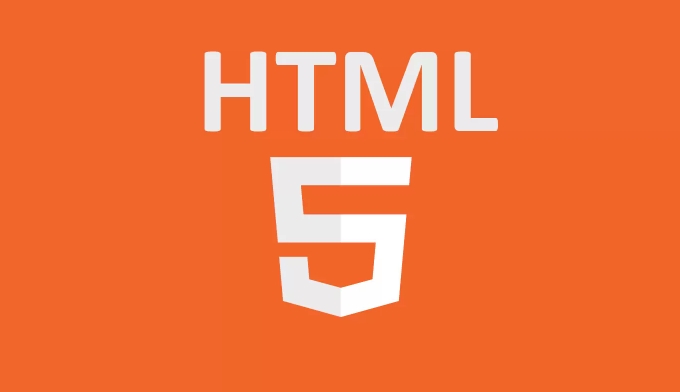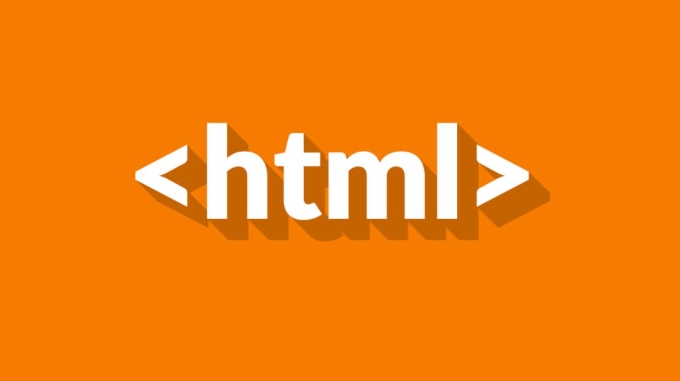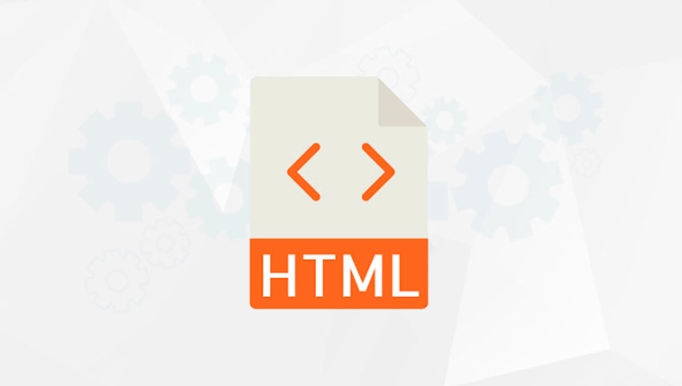The key points for handling HTML form submission are: 1. Use form tags and correctly set the action and method attributes; 2. Select the GET or POST submission method according to the purpose; 3. Make sure the form field contains the name attribute for data delivery; 4. Use HTML native verification or JavaScript for front-end verification, and be sure to perform secure verification on the server side. These key points can help avoid common problems and ensure that data is submitted correctly and securely to the server.

Handling HTML form submission is actually not that complicated, but there are some key points you have to pay attention to. Form submission is one of the most common features in web interaction, and it is inseparable from logging in, registering, or submitting comments. The key is how to correctly send data from the user to the server.

Basic structure of form submission
The most basic part of a form submission is the HTML <form></form> tag. It has two most important properties: action and method .
-
actionspecifies the destination address of data submission (that is, the server-side handler). -
methodspecifies which method to submit, the most common areGETandPOST.
Let's give a simple example:

<form action="/submit" method="POST"> <label for="name">Name:</label> <input type="text" id="name" name="name"> <button type="submit">Submit</button> </form>
When the user clicks the "Submit" button, the browser will send the content in the input box as name field to the /submit address. The server needs to have corresponding codes to receive and process this data.
Submission method: GET or POST?
Choosing to use GET or POST is actually quite intuitive:

- GET : Suitable for obtaining data, such as search, filtering, etc. The data will be displayed on the URL, so it is not suitable for sensitive information.
- POST : Suitable for submitting, modifying data or performing operations. The data will not appear in the URL, which is a bit safer.
For example:
- Use
POSTon the login page because the password cannot be exposed to the URL. - The search page can be
GET, so that users can directly copy the link to share search results.
The name attribute of the form field is important
You may not pay much attention, but the form data is passed based on name attribute. for example:
<input type="text" name="email" />
The data received by the server will have a structure similar to this: { "email": "用戶輸入的內(nèi)容" } .
So, if you forget to write name attribute, the data in this field will not be transmitted to the server. This is particularly easy to ignore, especially when dynamically generating forms.
How to handle verification before form submission?
Before the data is sent out, we usually do some basic checks, such as whether the required items have been filled in, whether the email format is correct, etc. HTML provides some native verification methods, such as:
-
required: marked as required -
type="email": Automatically verify the mailbox format -
minlength/maxlength: limit input length
<input type="email" name="email" required>
If you want to control the verification logic more flexibly, you can also use JavaScript to make judgments in the submit event. for example:
document.querySelector('form').addEventListener('submit', function(e) {
const email = document.querySelector('[name="email"]').value;
if (!email.includes('@')) {
e.preventDefault(); // Prevent the default submission behavior alert('Please enter the correct email');
}
});However, front-end verification is only part of the user experience, and real security verification still needs to be done on the server side.
Basically that's it. Form submission seems simple, but many problems lie in the details, such as missing name , using the wrong method , or failing to verify it well. As long as you pay attention to these key points, most problems can be avoided.
The above is the detailed content of Handling Form Submissions in HTML. For more information, please follow other related articles on the PHP Chinese website!

Hot AI Tools

Undress AI Tool
Undress images for free

Undresser.AI Undress
AI-powered app for creating realistic nude photos

AI Clothes Remover
Online AI tool for removing clothes from photos.

Clothoff.io
AI clothes remover

Video Face Swap
Swap faces in any video effortlessly with our completely free AI face swap tool!

Hot Article

Hot Tools

Notepad++7.3.1
Easy-to-use and free code editor

SublimeText3 Chinese version
Chinese version, very easy to use

Zend Studio 13.0.1
Powerful PHP integrated development environment

Dreamweaver CS6
Visual web development tools

SublimeText3 Mac version
God-level code editing software (SublimeText3)

Hot Topics
 How to develop AI intelligent form system with PHP PHP intelligent form design and analysis
Jul 25, 2025 pm 05:54 PM
How to develop AI intelligent form system with PHP PHP intelligent form design and analysis
Jul 25, 2025 pm 05:54 PM
When choosing a suitable PHP framework, you need to consider comprehensively according to project needs: Laravel is suitable for rapid development and provides EloquentORM and Blade template engines, which are convenient for database operation and dynamic form rendering; Symfony is more flexible and suitable for complex systems; CodeIgniter is lightweight and suitable for simple applications with high performance requirements. 2. To ensure the accuracy of AI models, we need to start with high-quality data training, reasonable selection of evaluation indicators (such as accuracy, recall, F1 value), regular performance evaluation and model tuning, and ensure code quality through unit testing and integration testing, while continuously monitoring the input data to prevent data drift. 3. Many measures are required to protect user privacy: encrypt and store sensitive data (such as AES
 The `` vs. `` in HTML
Jul 19, 2025 am 12:41 AM
The `` vs. `` in HTML
Jul 19, 2025 am 12:41 AM
It is a block-level element, used to divide large block content areas; it is an inline element, suitable for wrapping small segments of text or content fragments. The specific differences are as follows: 1. Exclusively occupy a row, width and height, inner and outer margins can be set, which are often used in layout structures such as headers, sidebars, etc.; 2. Do not wrap lines, only occupy the content width, and are used for local style control such as discoloration, bolding, etc.; 3. In terms of usage scenarios, it is suitable for the layout and structure organization of the overall area, and is used for small-scale style adjustments that do not affect the overall layout; 4. When nesting, it can contain any elements, and block-level elements should not be nested inside.
 How to build a user feedback system with PHP. PHP feedback collection and processing process
Jul 23, 2025 pm 06:09 PM
How to build a user feedback system with PHP. PHP feedback collection and processing process
Jul 23, 2025 pm 06:09 PM
The database structure design of the user feedback system must include core fields such as id (primary key), user_id (user association), feedback_type (feedback type), message (feedback content), status (processing status), created_at and updated_at (timestamp), to ensure data integrity and scalability; 2. The key steps for PHP to implement feedback submission and verification include: front-end form POST data, first verify (such as empty(), filter_var() check format after receiving PHP scripts (such as empty(), filter_var() check format) and then filter (htmlspecialchars() prevent XSS), and use preprocessing statements (PDO or MySQLi) to prevent S
 Specifying Character Encoding for HTML Documents (UTF-8)
Jul 15, 2025 am 01:43 AM
Specifying Character Encoding for HTML Documents (UTF-8)
Jul 15, 2025 am 01:43 AM
To correctly set the character encoding of the HTML document to UTF-8, you need to follow three steps: 1. Add at the top of the HTML5 part; 2. Configure the response header Content-Type: text/html; charset=UTF-8, if Apache uses AddDefaultCharsetUTF-8, Nginx uses charsetutf-8; 3. Select the UTF-8 encoding format when saving HTML files in the editor. These three links are indispensable, otherwise it may lead to garbled page code and failure of special character parsing, affecting user experience and SEO effect. It is important to ensure that HTML declaration, server configuration and file saving are consistent.
 Essential HTML Tags for Beginners
Jul 27, 2025 am 03:45 AM
Essential HTML Tags for Beginners
Jul 27, 2025 am 03:45 AM
To get started with HTML quickly, you only need to master a few basic tags to build a web skeleton. 1. The page structure is essential, and, which is the root element, contains meta information, and is the content display area. 2. Use the title. The higher the level, the smaller the number. Use tags to segment the text to avoid skipping the level. 3. The link uses tags and matches the href attributes, and the image uses tags and contains src and alt attributes. 4. The list is divided into unordered lists and ordered lists. Each entry is represented and must be nested in the list. 5. Beginners don’t have to force memorize all tags. It is more efficient to write and check them while you are writing. Master the structure, text, links, pictures and lists to create basic web pages.
 Shadow DOM Concepts and HTML Integration
Jul 24, 2025 am 01:39 AM
Shadow DOM Concepts and HTML Integration
Jul 24, 2025 am 01:39 AM
ShadowDOM is a technology used in web component technology to create isolated DOM subtrees. 1. It allows the mount of an independent DOM structure on ordinary HTML elements, with its own styles and behaviors, and does not affect the main document; 2. Created through JavaScript, such as using the attachShadow method and setting the mode to open; 3. When used in combination with HTML, it has three major features: clear structure, style isolation and content projection (slot); 4. Notes include complex debugging, style scope control, performance overhead and framework compatibility issues. In short, ShadowDOM provides native encapsulation capabilities for building reusable and non-polluting UI components.
 PHP realizes multi-user blog system monetization PHP blog content management and profit solution
Jul 23, 2025 pm 06:03 PM
PHP realizes multi-user blog system monetization PHP blog content management and profit solution
Jul 23, 2025 pm 06:03 PM
To build a monetizable PHP multi-user blog system, you need to build a solid technical foundation and then design a business model; 2. Data security must be pre-processed to prevent SQL injection, password salt hashing, XSS/CSRF defense, and regular patch updates; 3. Performance optimization relies on database indexing, caching mechanism (Redis), CDN to accelerate static resources, and asynchronous queue processing tasks; 4. Content review can adopt a hybrid mode of pre- (new user) and post- (old user) combined with AI recognition and keyword filtering; 5. In addition to advertising, profit methods can also provide paid subscriptions (customized domain names, data analysis), rewards, knowledge payment, affiliate marketing and event sponsorship.
 Can you put a tag inside another tag?
Jul 27, 2025 am 04:15 AM
Can you put a tag inside another tag?
Jul 27, 2025 am 04:15 AM
?Youcannotnesttagsinsideanothertagbecauseit’sinvalidHTML;browsersautomaticallyclosethefirstbeforeopeningthenext,resultinginseparateparagraphs.?Instead,useinlineelementslike,,orforstylingwithinaparagraph,orblockcontainerslikeortogroupmultipleparagraph






